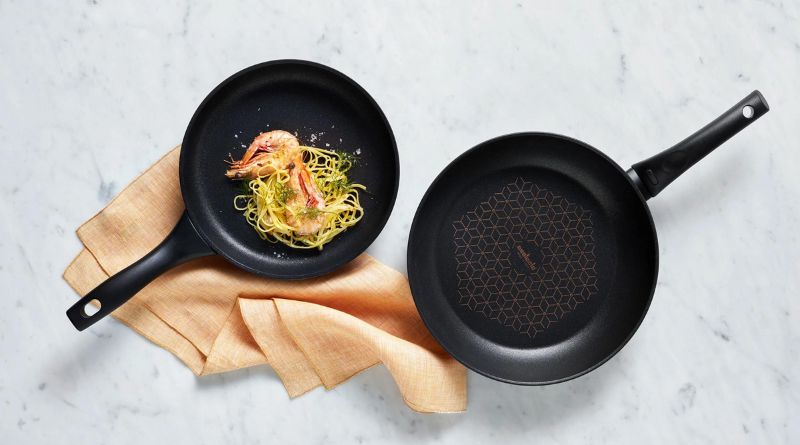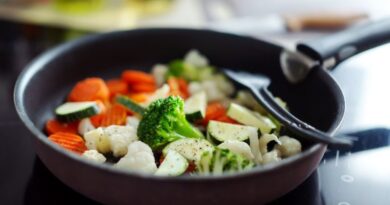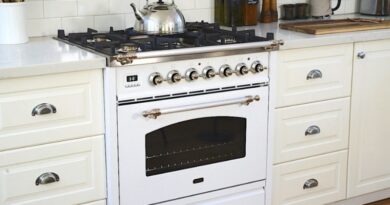The article gives you a brief discussion of saute pan vs frying pan. Unfortunately, even seasoned cooks are prone to mixing up and using the phrases skillet, frying pan, and sauté pan interchangeably when referring to cooking pans. This is one of the many reasons why purchasing cookware has historically been a time-consuming and challenging endeavor. However, we want to make it easy for you to understand your cookware requirements, so please bear with us while we attempt to clear up the uncertainty between saute pan vs frying pan.
The most straightforward method to distinguish between these two kinds of pans is to glance at the edges of the pan. If the edges of the pan are slanted, the pan is referred to as a frying pan, also known as a skillet or fry pan. If the slides are straight, the pan is referred to as a sauté pan.
Frying Pan
A frying pan, also known as a fry pan or a skillet, is a shallow pan with slanted sides used for frying food. Skillets are widely used for stir-frying or sautéing, which refers to a technique of cooking in which items are cooked rapidly in a tiny quantity of oil or fat, sometimes over high heat, to retain their flavor and texture. Having slanted edges makes it easy to mix, toss, and turn the items in the pan, which results in everything cooking more rapidly and evenly. For one thing, the French term for “sauté” literally translates as “jump,” which is precisely what happens when veggies are sautéed or stir-fried in a pan.
In addition to this, a frying pan is regarded as one of the most versatile pieces of cookware in the kitchen due to its many different applications. In this case, a stainless steel frying pan is ideal for searing meat, poultry, or fish and preparing essential pasta dishes or pan sauces in a hurry. To put it simply, To put it simply, an iron frying pan is one of the most versatile pieces of cookware you may have in your kitchen, to put it simply.
Also Read- 5 Best Heat Diffuser For Glass Top Stove 2023
Saute Pan
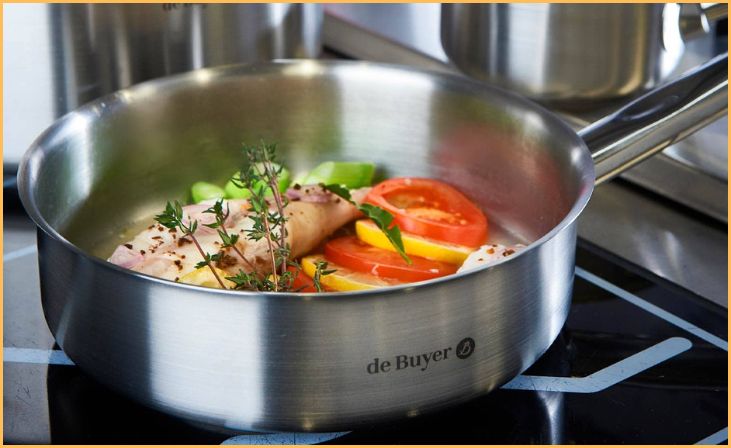
A sauté pan is a pan with straight sides used for frying. As previously stated, this is the most significant distinction between a sauté pan and a skillet or frying pan, which has slanted sides. In addition, straight sides make the sauté pan more suitable for some chores that involve cooking materials in a liquid, such as shallow frying or braising, since liquids may seep over the slated sides of a skillet when used for these types of activities.
In the same way that a skillet may be used to sauté, stir-fry, or sear, a sauté pan can also be used to do so. While a sauté pan may seem like the finest choice for sautéing food, some chefs prefer the slanted edges of a skillet for this purpose, which they believe is due to their culinary training.
Saute Pan Vs Frying Pan
Volume
Saute Pan Vs Frying Pan: Because of the straight edges of a sauté pan, you can accommodate a larger volume of liquid into an equal amount of oven space as before. As a bonus, straight sides reduce the likelihood of liquid spilling out when you move the pan around or transfer it into and out of the oven. It also enables the lid to be fitted more firmly, reducing evaporation. So when you’re doing jobs like shallow-frying a pan full of meatballs in a half-inch of oil or braising dozen chicken thighs in white wine, having a little additional volume is a huge help.
Surface Area
Pans are measured using the diameter of the lip, not by the diameter of the cooking surface, as is the case with pots. The majority of home burners can only easily accommodate a pan with a diameter of around 12 inches. As a result of its straight edges, a 12-inch sauté pan will have a big cooking surface that measures 12 inches in width (about 113 square inches). On the other hand, a skillet loses at least an inch on each side, resulting in a cooking surface that is just 10 inches broad when fully extended (about 79 square inches). This implies that if you have a skillet and a sauté pan with the same diameter, the skillet will have 30 percent less cooking surface than the sauté pan, and vice versa. That is not a negligible sum of money.
Evaporation
The shape of a pan may impact how readily moisture is drained from food and how quickly a sauce reduces temperature. For instance, it is sometimes said that the sloping sides of a pan aid in the quick evaporation of moisture released by cooking foods, enabling you to sear your meats more effectively. And this is correct, but only if the cooking area is the same as before. So, a 12-inch skillet with a 10-inch cooking surface will sear meals more effectively than a 10-inch sauté pan with the same cooking surface area. Naturally, the corollary to this is that when cooking an equal amount of food that requires searing over extremely high heat (for example, some steaks), the large surface area of a sauté pan does not provide any significant advantages over a skillet—you’ll still have to cook in batches just as often.
Tossing Ability
Ironically, a skillet is considerably better than a sauté pan when sautéing food. Sautéing is a technique in which tiny to medium-sized bits of food are cooked quickly in hot oil while being constantly stirred. Sloping sides of a skillet make it easy to shake the pan and conduct the jump-flip move that chefs like to demonstrate their skills. More than simply ego-puffing is going on here, however. Cooking evenly across the pan is achieved by the most effective redistribution method of food redistribution in the pan.
Cooking with a straight-sided sauté pan is doable, but it is difficult and time-consuming, needing continual stirring and turning with a wooden spatula or spoon to prevent sticking.
So, Which One is For You?
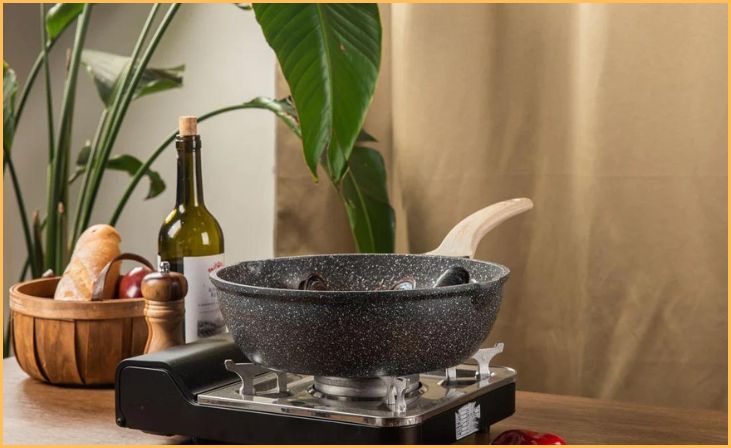
Choosing between a sauté pan frying pan is not a simple decision. There is a great deal of ambiguity between the two titles, and many individuals use the two names interchangeably. But, throw in a cast-iron skillet, which looks just like a saute pan, and we’re right back where we started.
So, here’s a straightforward method for determining which pan to use and when to use it.
Selecting a Saute Pan If:
- You’re preparing cuisine that has a lot of liquid.
- If you’re cooking anything for an extended amount of time, you’ll want the evaporation to be slower.
- If you’re frying, braising, poaching, or cooking one-pot foods that call for longer sides, this is the recipe for you.
If you are looking for a skillet, consider the following:
- If you’re going to flip anything, you’ll need easy access with a spatula (i.e., eggs or fish)
- You want shallow sides so that liquid may be reduced fast.
- Make stir-fries that need tossing and turning, which will take a while.
Saute Pan Vs Frying Pan: Summary
- Fry pans are flat-bottomed cooking vessels with sloping sides and no cover. A saute pan is a pan with straight sides and a cover that fits over the pan in the kitchen.
- The sauté pan has a deeper bottom and can contain more liquid than the frying pan, which is more profound and can retain less liquid.
- The sauté pan is used for high-heat cooking rather than frying instead of frying pans.
- Stirring the food on a sauté pan is preferable. However, turning the meal over in a frying pan is simple and quick.
- In contrast to the frying pan, a sauté pan has a broad, flat bottom.
- A saute pan is used to sauté chicken and other meat without overcooking or scorching it. Cooking meat and other foods in a frying pan can steam and brown the meat and other items.
For More- 5 New Greatest Sizzling Plates
Conclusion
In conclusion, the Saute Pan vs. Frying Pan comparison highlights the importance of choosing the right tool for your culinary needs. The sauté pan’s versatility in handling liquid-based dishes and controlled cooking contrasts with the frying pan’s proficiency in quick, high-heat tasks and efficient evaporation for crispy textures. While some interchangeability is possible, understanding their unique features empowers you to make informed decisions in the kitchen. Whether you’re sautéing vegetables or searing meats, selecting the appropriate pan enhances the precision of your cooking techniques, leading to delicious and well-crafted meals. Consider your favorite recipes and cooking styles to determine whether the sauté pan or frying pan deserves a prominent place in your kitchen arsenal, ensuring that each meal is a culinary success.
FAQs
A sauté pan has straight sides and is deeper, ideal for cooking with liquids. A frying pan has sloped sides, perfect for quick, high-heat cooking.
While possible, it’s not ideal. Sauté pans lack the surface area for effective frying, and frying pans may not provide enough depth for sautéing with liquids.
A frying pan is typically better for searing meats due to its wider surface and sloped sides, allowing for efficient evaporation of moisture and achieving a crispy texture.

